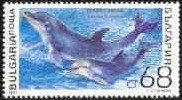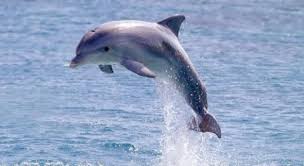Stamp: Common Bottlenose Dolphin (Tursiops truncatus) (Bulgaria 1991)
Common Bottlenose Dolphin (Tursiops truncatus) (Bulgaria 1991)
24 December (Bulgaria ) within release Sea Mammals goes into circulation Stamp Common Bottlenose Dolphin (Tursiops truncatus) face value 68 Bulgarian stotinka
| Stamp Common Bottlenose Dolphin (Tursiops truncatus) in catalogues | |
|---|---|
| Michel: | Mi:BG 3962 |
Stamp is horizontal format.
Also in the issue Sea Mammals:
- Stamp - Harp Seal (Pagophilus groenlandicus) face value 30;
- Mini Sheet - Mini Sheet with No. 3959-64 face value 5.03;
- Stamp - Killer Whale (Orcinus orca) face value 43;
- Stamp - Walrus (Odobenus rosmarus) face value 62;
- Stamp - Common Bottlenose Dolphin (Tursiops truncatus) face value 68;
- Stamp - Mediterranean Monk Seal (Monachus monachus) face value 1;
- Stamp - Harbour Porpoise (Phocaena phocaena) face value 2;
Stamp Common Bottlenose Dolphin (Tursiops truncatus) it reflects the thematic directions:
Mammals are any vertebrates within the class Mammalia (/məˈmeɪli.ə/ from Latin mamma "breast"), a clade of endothermic amniotes distinguished from reptiles (including birds) by the possession of a neocortex (a region of the brain), hair, three middle ear bones and mammary glands. All female mammals nurse their young with milk, secreted from the mammary glands. Mammals include the largest animals on the planet, the great whales. The basic body type is a terrestrial quadruped, but some mammals are adapted for life at sea, in the air, in trees, underground or on two legs. The largest group of mammals, the placentals, have a placenta, which enables the feeding of the fetus during gestation. Mammals range in size from the 30–40 mm (1.2–1.6 in) bumblebee bat to the 30-meter (98 ft) blue whale. With the exception of the five species of monotreme (egg-laying mammals), all modern mammals give birth to live young. Most mammals, including the six most species-rich orders, belong to the placental group. The largest orders are the rodents, bats and Soricomorpha (shrews and allies). The next three biggest orders, depending on the biological classification scheme used, are the Primates (apes and monkeys), the Cetartiodactyla (whales and even-toed ungulates), and the Carnivora (cats, dogs, seals, and allies).
Marine mammals are mammals that rely on marine (saltwater) ecosystems for their existence. They include animals such as cetaceans (whales, dolphins and porpoises), pinnipeds (seals, sea lions and walruses), sirenians (manatees and dugongs), sea otters and polar bears. They are an informal group, unified only by their reliance on marine environments for feeding and survival.
A dolphin is an aquatic mammal within the infraorder Cetacea. Dolphin species belong to the families Delphinidae (the oceanic dolphins), Platanistidae (the Indian river dolphins), Iniidae (the New World river dolphins), Pontoporiidae (the brackish dolphins), and possibly extinct Lipotidae (baiji or Chinese river dolphin). There are 40 extant species named as dolphins.
Animals are multicellular, eukaryotic organisms of the kingdom Animalia (also called Metazoa). All animals are motile, meaning they can move spontaneously and independently, at some point in their lives. Their body plan eventually becomes fixed as they develop, although some undergo a process of metamorphosis later on in their lives. All animals are heterotrophs: they must ingest other organisms or their products for sustenance.




